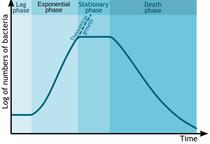 | ||||
Microbial Growth
Review Questions
Virtual Microbiology Classroom of Science Prof Online
Microbial Growth Review Questions
Microbial Growth
Practice Test Questions
These multiple choice and true/false questions are designed to help students better understand this topic.
SPO VIRTUAL CLASSROOMS
 | ||||||
1. Explain what “microbial growth” means.
2. What are the 4 phases of the microbial growth curve?
3. How does binary fission result in exponential growth?
4. How does bacterial generation time relate to characteristics of disease?
5. Below are microbes that we met in this lecture. Discuss each microbe below with respect to the factor we discussed as affecting its growth.
- Mycobacterium tuberculosis and Generation time
- Mycobacterium leprae and Generation time
- Chlamydomonas nivalis and Temperature
- Listeria monocytogenes and Temperature
- Helicobacter pylori: pH & Oxygen
- Campylobacter jejuni and Oxygen
- Vibrio cholorae and pH
- Staphylococcus epidermidis and Osmostic pressure
6. Support or refute the following statement: Microbes cannot tolerate the low pH of the human stomach.
7. Describe 5 factors that can limit bacterial growth.
8. Why are high temperatures (far outside the normal range) detrimental to most organisms?
9. Describe the groupings of microorganisms as categorized by their optimal temperature range.
10. Describe the groupings of microorganisms based on the pH range that they exist in.
These are review questions from the Virtual Microbiology Classrooms (8-weeks & 16-weeks), designed to help students better understand microbial growth. They are based on materials that can be found on the Microbial Growth Lecture Main Page.
SCIENCE PHOTOS
Virtual Microbiology Classroom provides a wide range of free educational resources including PowerPoint Lectures, Study Guides, Review Questions and Practice Test Questions.
Page last updated: 2/2016
11. Describe how the osmotic tolerance of an organism such as Staphylococcus differs from the osmotic tolerance of of E. coli. What cellular structure is this difference based on?
12. Why are we able to keep honey in the cupboard rather than the refrigerator? In other words, why don’t we need to worry about bacterial growth in honey?
13. Eating honey can result in botulism, especially in young children. Why would a person be able to contract botulism, a bacterial disease, if bacteria cannot grow in honey?
14. Using oxygen results in toxic waste products. What special ability do aerobic organisms have that enables them to use oxygen.
15. What do aerobic organisms use oxygen for?
16. Why would facultative anaerobes "want to" use oxygen if it is available, especially since it using oxygen results in toxic waste products?





